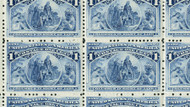The Fascinating World of Blind Perforations on Postage Stamps
Posted by Mystic Stamp Co. on 27th Jun 2024
Blind perforations, often an overlooked aspect of philately, add an intriguing dimension to the study and collection of postage stamps. For those unacquainted with the term, blind perforations refer to perforations that are not fully punched out, leaving tiny bits of paper connecting the stamps. This phenomenon offers a glimpse into the production quirks and historical context of stamp manufacturing.
The Origins and Mechanics of Perforations
Perforations, the series of small holes punched between stamps on a sheet, were introduced to make it easier to separate individual stamps. Before the advent of perforations in the mid-19th century, stamps were manually cut from sheets, which was time-consuming and often resulted in uneven edges.
The perforation process involves a comb or line perforating machine that punches holes along the designated lines. Ideally, this results in a clean separation line for each stamp. However, due to various factors such as machine malfunctions, worn-out perforating pins, or improper alignment of the sheets, some holes may not be completely punched through, leading to blind perforations.
Identifying Blind Perforations
Recognizing blind perforations requires a keen eye and a magnifying glass. These incomplete perforations may appear as tiny paper bridges connecting adjacent stamps. Sometimes, they are so subtle that they are only noticeable upon close inspection. Collectors often encounter blind perforations in older stamps, where manufacturing processes were less refined than they are today.
The Appeal to Collectors
For philatelists, blind perforations represent more than just a manufacturing flaw. They are a testament to the historical and technological evolution of stamp production. Collectors prize them for several reasons:
- Historical Significance: Blind perforations often indicate a specific period or batch in the production process, offering insights into the operational challenges of early stamp production.
- Rarity and Uniqueness: As a relatively uncommon occurrence, stamps with blind perforations can be rarer and thus more valuable. Each stamp tells a unique story, making it a distinctive piece in a collection.
- Aesthetic Appeal: The imperfect nature of blind perforations adds character and a sense of authenticity to a stamp. It reminds collectors of the human element in stamp production.
Collecting Tips
For those interested in adding stamps with blind perforations to their collection, here are a few tips:
- Condition Matters: While blind perforations add uniqueness, the overall condition of the stamp is still crucial. Look for stamps that are otherwise well-preserved.
- Documentation: Proper documentation can enhance the value of stamps with blind perforations. Keep records of the stamp’s origin, production details, and any historical significance.
- Expert Opinion: Seek opinions from seasoned collectors or philatelic experts to verify the authenticity and value of stamps with blind perforations.
Conclusion
Blind perforations, with their unique charm and historical value, are a fascinating aspect of philately. They serve as a bridge between the past and present, illustrating the evolution of stamp production and adding depth to any collection. Whether you are a seasoned collector or a novice, the discovery of blind perforations can enhance your appreciation for the intricate world of postage stamps. So, next time you examine a stamp, take a closer look—you might just uncover a hidden gem in the form of a blind perforation.

